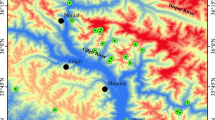Summary
It has been established that the electrodes of the dialyser in a chloro-alkali plant in Eastern India release mercury beyond the permissible limits into the River Koel. Mercury in elemental form, as well as certain organo-mercury compounds, including methyl mercury, have been detected at a distance of 25 km from the discharge point. Even at a distance of 5–10 km, the mercury content of the sediment may be as high as 0.6–3.2 mg kg−1 above the value of sediment upstream of the plant. This sediment itself is contaminated, probably by battery and paint factories, etc., still further upstream. Thus, the chloro-alkali factory has contributed 60–320 times above the permissible limit (0.01 mg kg−1) of mercury release, at a distance of 5–10 km from the point of release. Furthermore, various phytoplankton and zooplankton have been contaminated, leading to very high mercury contents in certain fish. This food chain, therefore, threatens man himself.
Similar content being viewed by others
References
AOAC. 1975.Official Methods of Analysis, 12th edn. Association of Official Analytical Chemists, Washington, DC, USA.
Astin, S.R., Thornton, I., Webb, J., Parves, J.B., Milford, B.L. 1974. Stream sediment composition: An aid to water quality assessment.Water, air, soil pollution,3, 321–325.
Bothner, M.H. and Carpenter, R. 1973. The rate of mercury loss from contaminated estuary sediment in Bellingham Bay, Washington. Proc. of the 1 st Ann. N.S.F. Trace contaminants conference. Oak Ridge National Laboratory, USA.
Chau, Y.K. and Saitoh, H. 1973. Determination of methylmercury in lake water.Int. J. Environ. Anal. Chem.,3, 139.
Fujiki, M. 1973. The transitional condition of Minamata Bay and the neighbouring Sen polluted by factory waste containing mercury. In: Jenkson, J.M. (ed.),Advances in water pollution research, pp. 905–920, Pergamon, Oxford.
Hirota, K. 1974. Mercury content of phytoplankton collected in Anjalic and Yataushiko KI.Bull. Jap. Soc. Sci. Fish,40, 393–397.
Hirota, K., Fujiki, M. and Tajma, S. 1974. Mercury contents of zooplankton collected in the tropical pacific cocan. Bull. of Japanese Society of Sci. Fisheries,45(11), 1449–1451.
Irakayama, K. 1967. The pollution of Minamata Bay and Minamata diseases. Advan. Water.Pollut. Res. Proc. 3rd Int. Conference,3, 153. Munich, Germany.
Jernelov, A. and Lann, M.A. 1971. Mercury accumulation in food chain.Oikos,22, 402–406.
Suckcheroen, S. 1980. Mercury contamination of terrestrial vegetation near a caustic soda factory in Thailand.Bull. Env. Cont. Toxicol.,24, 463–466.
Westoo, G. 1966. Determination of methyl mercury compound in fish. Identification and determination.Acta. Chem. Scand.,20, 2131–2137.
Author information
Authors and Affiliations
Additional information
Dr Sajalendu Nanda is currently a Research Associate at Bangur Institute of Neurology in Calcutta. He possesses an MSc in Environmental Biology and a PhD in Ecology. His address for correspondence is c/o Dr P.K. Tapaswi, Professor-in-Charge at the Biological Sciences Division of the Indian Statistical Institute.
Rights and permissions
About this article
Cite this article
Nanda, S. The environmental impact of a chloro-alkali factory in a river basin in Eastern India. Environmentalist 13, 121–124 (1993). https://doi.org/10.1007/BF01905669
Issue Date:
DOI: https://doi.org/10.1007/BF01905669




